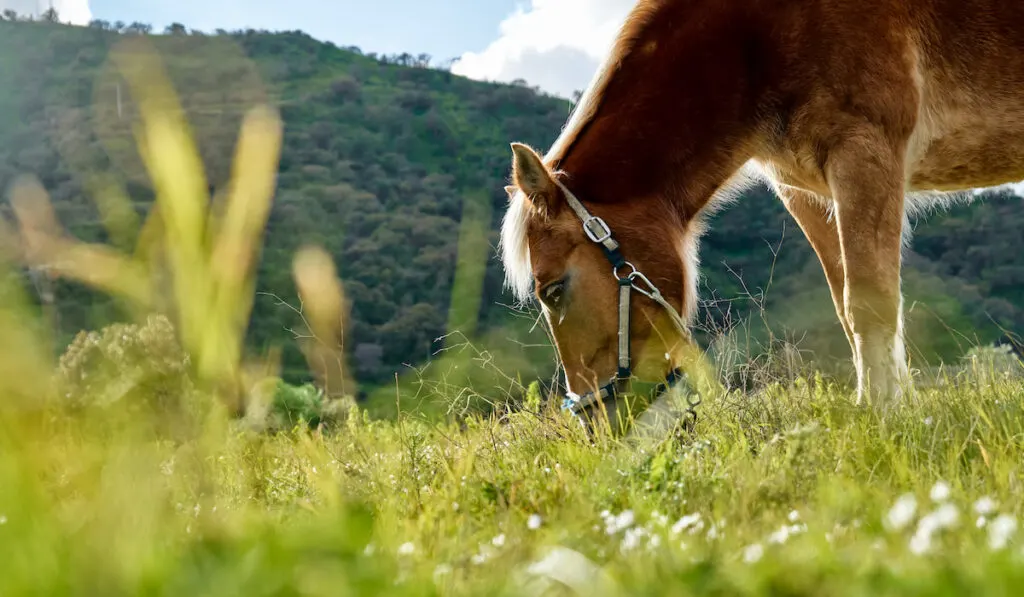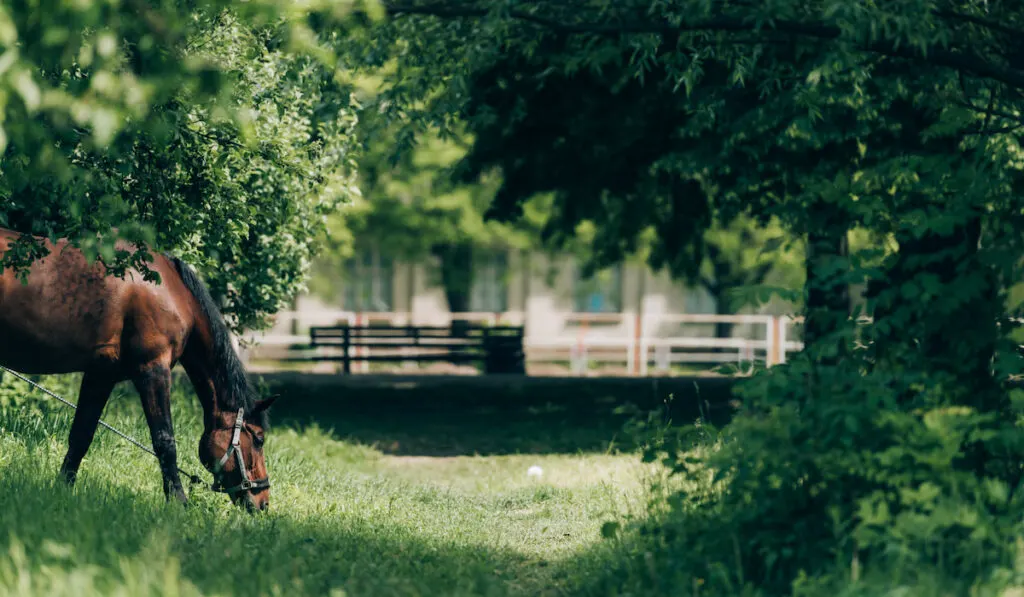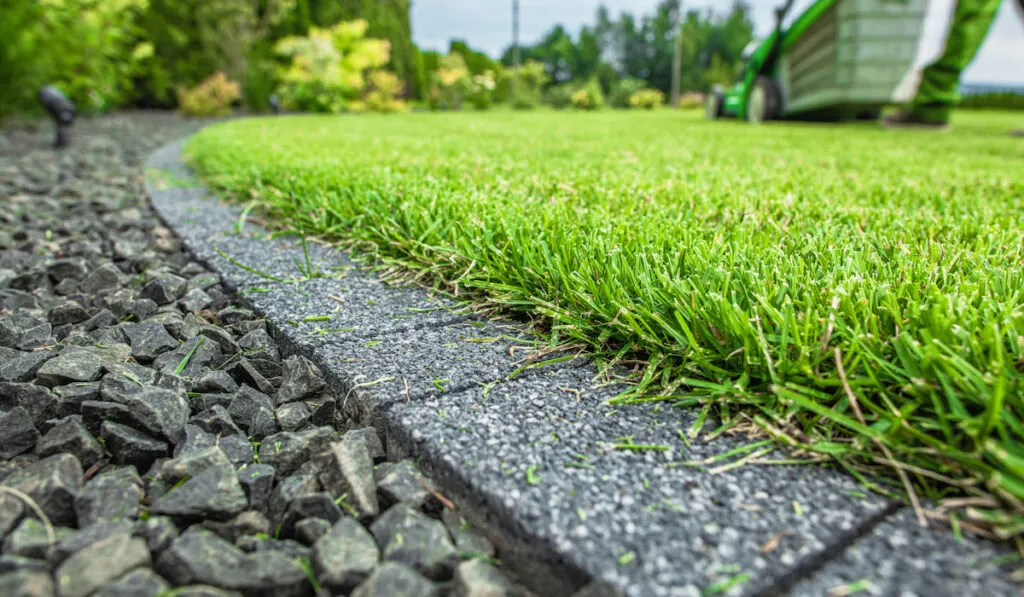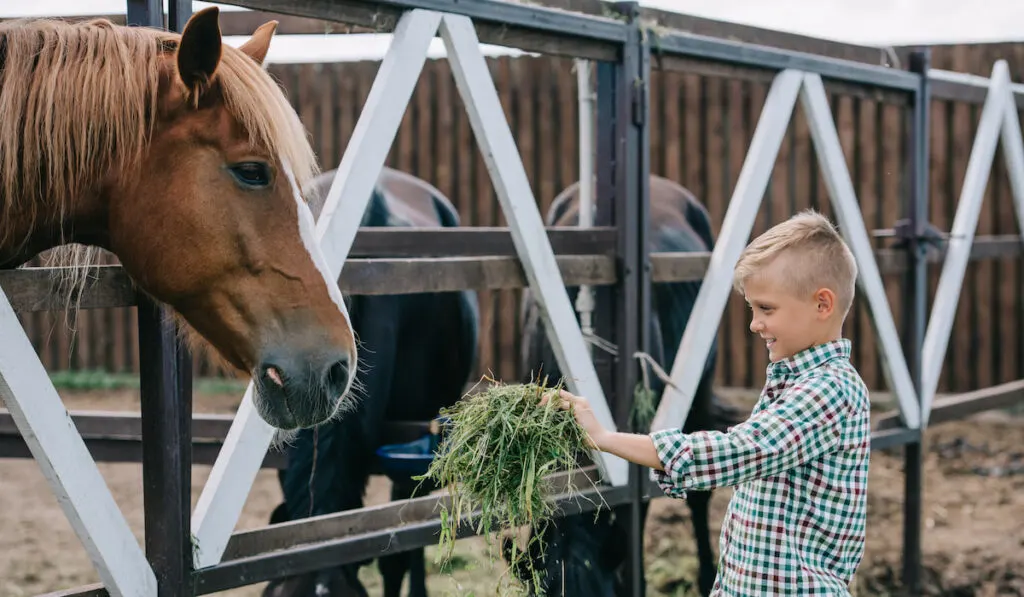When you are driving past farmland, it is almost a guarantee that at some point you’ll get to call out “Horses!” as you pass a herd in a field, their heads to the ground, barely pausing from eating the field. Horses do seem to enjoy munching on some grass, it seems, so that raises a good question:
Can a horse live off of eating just grass (especially typical lawn grass) alone? Horses should not be fed a diet consisting solely of lawn or grass clippings. Special, nutrient rich pasture grass is recommended for horses if it is their only forage source.

If we are talking about typical lawn grass, and not specifically planted and nutrient-rich pasture grass, it really isn’t a great option for horses. Regular old lawn grass is fine for a snack and some filler, but there simply are not enough vitamins and nutrients in it to sustain a healthy diet for long for any horse.
So while, yes, you do see horses munching away on the greenery an awful lot, pasture grass is a step beyond regular grass grown in front and back yards (and is usually paired with hay, sweet feed and other supplements as well). The longer answer, though, deals a lot more with the different types of grasses, what nutrients a horse needs and what supplements are made available for the animal.
In our article on beer for colic in horses, we explain how swapping from grass to hay may trigger a colic episode, so watch out for that!
Table of Contents
Grass-Fed Only: Can that Actually Work for a Horse?
We touched on this a bit already, but in short form the answer is a two parter: decidedly not for typical yard grass, typically not for pasture grass, either, unless it is top tier nutrient and vitamin enriched, though there are some quality fields that can do the trick.
Evolution has indeed played a hand in a horse’s body receiving all the nutrition it needs from grass, in theory, that is. While wild grasses and strategic fields do possess the vitamins and nutrients needed, most of the grass we see these days is of a different variety (source).
That is to say, grass planted at most homes has been selected for aesthetic qualities (bright green color, soft feel, uniform growth and easy to maintain) over nutritional qualities. So, while lawn grass may still look like a buffet salad fit for a pony, it simply isn’t nutritious enough.

Similar to how iceberg lettuce is a great salad filler but delivers very little in the way of nutrition, so does lawn grass to horses. They would need a “lawn salad” of romaine lettuce, spinach, kale, arugula, etc. – you get the picture.
Further, even good quality grasses are affected by any number of external factors such as overgrazing, cold snaps, heat waves, drought, declining soil quality and more.
All these potential instances have the ability to severely change and degrade the amount of nutrients in grass. As such, even professionally managed pastures may not have all a horse needs.
Certain vitamins, fats and macrominerals essential to an equine diet (calcium, phosphorous, sodium, potassium, chloride, magnesium, and sulfur) simply are not found in regular grass alone.
Common Types of Pasture Grass for Horses
We’ve touched a bit on pasture quality grass versus regular lawn grass, but what really are the common types of grasses available to horses in pastures? There are countless grass varieties, but most pastures will be comprised of one of five main types: Kentucky bluegrass, orchardgrass, bermudagrass, tall fescue and white clover. (source)
Kentucky Bluegrass

Let’s start with the most common variety: Kentucky bluegrass. Yes, more than just a music genre, bluegrass is a favorite of pasture management.
Because it is relatively adaptable and does not need extreme temperatures to thrive, many temperate regions in the United States employ this grass in their pasture.
It goes through repeated growth cycles in the spring and the fall when temperatures are milder, and is ready to be eaten by horses all summer long.
This variety is recognizable by its fine-tipped blade and darker green color, plus it grows close to the ground in tight little clumps making it an easy and manageable grass for horses to graze on.
Orchard Grass
Orchardgrass is another cool-season growing grass that is often used instead of or in conjunction to Kentucky bluegrass.
While it, too, has a deep blueish green tint, its blades are finer, softer and wider than bluegrass. Horses very much take to eating orchardgrass and it grows more bountiful and in higher yields than Kentucky bluegrass, too.
One of its downsides, though, is that its growth pattern tends to be patchy and does not coat a full field evenly. Plus, too much grazing or too short clipping causes it to stop growing, so it is much harder to manage.
Bermuda Grass
Bermuda grass is a type of grazing grass you find more often in the South, as it prefers a warmer climate to grow. Its blades are more wiry than bluegrass or orchard grass but it grows tightly and abundantly. When allowed to grow out, it makes for an excellent grass to dry and turn into hay for horses.
Fescue
Next up is tall fescue. Much like the first two mentioned, it is a cool-season grass. It grows together in bunches, much like orchardgrass, but is of heartier stock and is up to the challenge of frequent grazing and/or clipping.
Its dark green blades show prominent veins and grow rough, with serrated edges that can be painful to bare skin. Tall fescue does come with some risk, however, as it is prone to be infected by a fungus that can be fatally toxic to bloodmares. (source)
White Clover
Finally, there is white clover which is not technically even a grass, but rather a grass-like legume. It provides an excellent source of delicious nutrition for horse and is easy for them to forage, as it grows close to the ground and is hearty enough to withstand frequent grazing. You will often find white clover thriving in cool and wet climates.
How to Get Your Grass Tested for Nutrients

If you think you have a pasture that is perfect as it is for sustaining horses, or are simply curious about the nutrient make-up of your own lawn, you can actually get your grass tested to determine what nutrients it is naturally producing. Farm-focused and agricultural labs will often be able to test your grass for you to let you know just what your pasture is comprised of.
To get the right samples, you should scour every field and take small handfuls of grass, being sure to pluck off the approximate height your horses will eat and ensuring a good mixture of all the grasses and plants they tend to graze on, so that you have an accurate sample.
Your lab may want you to dehydrate the grass prior to sending it. It is best to follow the labs instructions on how to prepare samples prior to transport.
Typically, you should seal the samples in a plastic bag, squeeze out all excess air and you are ready to ship it off to a lab.
Your results will tell you the mineral and nutrient makeup of your grass, which will be able to help inform you which supplements your horses may need.
What Supplements Are Good for Horses Eating Grass
Once you are aware of what nutrients your grass has – or, rather, is lacking in – you can start purchasing the proper supplements for your horses’ diets.
You’ll want a supplement that adds minerals and vitamins into the diet, but also is not too high in sugar, as many pasture grasses usually are rich in sugars. Never fear, if you are feeling overwhelmed you can usually get more recommendations from your local agricultural extension.
Since horses on a pasture-based diet tend to have generally the same imbalances and holes in their nutrition, there are a few supplements that are often used.
Horse Guard , is one example of a supplement specially formulated to provide horses with balanced source of necessary vitamins and minerals.
Can a Horse Colic off a Grass-Heavy Diet?
A scary possibility to any horse owner is the threat of a horse colicing (gastrointestinal disorder commonly associated with abdominal pain and requiring veterinary attention.)
Too much of anything can be a bad thing, really, and can promote a horse to colic. The threat of horses colicing off a grass-heavy diet tends to come when they eat too much too quickly.
Hoses who are not used to grazing on pasture may over indulge, leading to colic. For that reason, grazing should be allowed only under a watchful eye and controlled.
However, in the long run, a grass-heavy diet may be just the thing to ensure your horse stays healthy! (source) A high-fiber and low-carb diet is the best kind of diet to maintain digestive health so, as long as you are observing your horse’s health, plenty of pasture time is actually a good thing.
Horses have evolved to digest and subsist off of grass containing the right mix of nutrients. With accurate testing and knowledgeable supplement additions, it is possible for a horse to have a healthy diet feeding in a pasture. However, a horse cannot live off of lawn grass alone.
Pasture grass for domestic horses is one thing but, you may wonder, if feeding horses is so difficult, how do they survive in the wild? Take a look at my article on the diet of the American Mustang Horse to learn more!
Related Posts
Source:
- https://articles.extension.org/pages/10270/nutrients-and-common-feed-sources-for-horses

